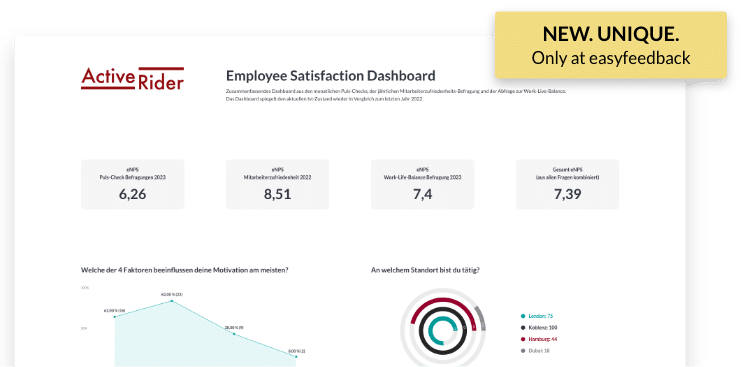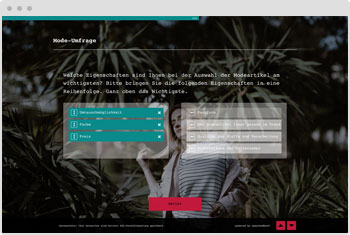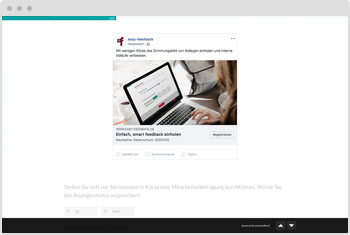Be one step ahead of your competitors with a competitive analysis

Find out who your competitors are in the market, what their strengths and weaknesses are, and how to shape your strategies for success based on the data.

“Identifying customer needs is an essential part of our business. easyfeedback accompanies us for many years as a loyal partner in this task. We particularly appreciate the intuitive usability of the survey tool as well as the professional support.”
Guild Lead User Experience Research

“We use easyfeedback for internal and external surveys – fast, comfortable and really easy! Straightforward and cordial support can always create a smile. We really appreciate the permanent development of the platform.”
Guest & Competitor Insights Analyst
Content and targets of this competitor analysis survey template
Whether starting a business, introducing new products or services, or entering new markets: Competitive analyses are an essential and nowadays integral part of entrepreneurial decisions.
Easily and quickly realized, they spark a great impact. The analysis of the obtained data has an enormous impact on strategic approaches in entrepreneurial development, because the targeted analysis of the market and the competitive situation can answer important questions about room for maneuver, niches and opportunities.
Especially start-ups can benefit from competitive, market and needs analyses, as they unfortunately often fall into the trap of failure due to flawed or immature business models or develop products that miss the market . Start-ups can protect themselves from these potential scenarios with 2-3 simple surveys.
But also for grown and established companies, regardless of size and industry, regular competitive analyses bring many, often previously unknown advantages: Because the competition does not sleep and tries to strengthen their respective market position through new ideas and strategies.
Therefore, use the potential of continuous competitive analyses to better assess the prospects for success and the possible market potential of your company in the future and to be able to make strategic decisions in an even more targeted manner.
Content:
• Query on personal impressions of the last shopping experience
• Evaluation of important aspects of the industry
• Identify and recognize market competitors
• Identify reasons for shopping with competitors
• Inquire about potential for improvement
Targets:
• Analyze competitor situation and market area through market research
• Quickly uncover process-related performance deficits
• Identify own scope for action and opportunities
• Identify potential trends at an early stage
• Develop entrepreneurial strategies accurately
• Strengthen own competitive position sustainably

Data privacy protection „made in Germany“ (GDPR)

Anonymity functions for open feedback
Almost everything you need to know about competitive analysis
1. What is a competitive analysis?
A competitive analysis is a strategy for examining the target market and the current and potential competitors with regard to their market shares, behavior and the products and services offered.
It is also the basis for making business decisions, as it can, for example, provide information on how competitive the target market is, what the prospects of success are for entering a new market or launching a new product, and what the marketing and sales strategies of competitors look like.
2. How is competitive analysis differentiated from competitor and market analysis?
Simple. Competitive analysis consists of competitor and market analysis. On the one hand, competitive analysis involves gathering comprehensive information about your competitors, for example, market position, sales channels, services or pricing, and comparing them with you.
On the other hand, you also need to analyze the market you are targeting or operating in the competitive analysis in order to determine market development, market share or market potential for products and services on the basis of concrete figures, data and facts.
This all adds up to the complete picture of a competitive analysis that helps you make strategic decisions for your company.
3. Why should I do a competitive analysis? What are the objectives?
Both for start-ups, to strengthen your own employer brand or to open up new markets, competitive analysis helps you make decisions based on a good foundation of data and information to minimize decision risks and ensure the success of your measures.
But the ultimate goal of a competitive analysis always depends on what you need a competitive analysis for.
Example:
You want to launch a new product, but you don’t know whether the product is suitable for the targeted market and target group, then you can use a competitive analysis, for example, to research competitor products and possible customer reviews and incorporate the information gathered into product development.
Another example:
You want to improve your employer brand in terms of recruiting new talent over the competition. With a competitive analysis, you can, for example, analyze your brand awareness and that of your competitors with regard to their employee satisfaction and branding strategies.
As you can see, for each purpose there are also different goals that a competitive analysis pursues.
4. What types of competitive analysis are there?
In general, there are two types of competitive analysis.
On the one hand, there is the strategic competition analysis, which is about the investigation of the industry and its market leaders. Here, factors such as the market constellation, the market position or the strengths and weaknesses of the individual competitors are analyzed.
On the other hand, there is the operational competitive analysis, in which, for example, products are compared on the basis of qualitative and quantitative criteria or marketing and sales activities of competitors are monitored.
5. Which key figures are important for a competitive analysis?
This cannot be said in a generalized way. Which key figures are important for your competitive analysis ultimately depends on the respective objective. That is, what is to be achieved in the end with the competitive analysis?
If you know this, then you can determine the comparison criteria you need for your analysis and then collect the information for it. Examples of relevant information could be the following, depending on the objective:
Strategic information:
- Company size and number of employees
- Company headquarters and locations
- Cooperation partners
- Special successes & awards
- Legal form
Operational information:
- Price
- Promotional activities
- Distribution/Sales Channels
- Services provided
- Product
Information on the company’s success:
- Market share
- Sales share
- Profit
- Cash Flow
- Profitability
6. How do I perform a competitive analysis?
Competitive analysis is easy and quick to implement and can be done in just a few steps. In the following we have listed 6 steps for the creation of your and explained in more detail:
1. Determine the goal
Before you start with a competitive analysis, you should first ask yourself the question, what is your goal? What is the purpose of the analysis? Do you want to introduce a new product, identify your performance gaps with competitors, or realign the company?
In the end, the objective will determine the focus and the information to be collected in the competitive analysis.
2. Define comparison criteria
After you have defined the goal of your competitive analysis, you now need to define the characteristics and criteria for the comparison and analysis.
Possible comparison criteria can be company data such as company size, sales figures or number of locations, or marketing and sales-relevant information such as sales channels used, sales and advertising measures or active sales markets.
As mentioned, the comparison criteria always depend on the objective and focus of your analysis.
3. Identify competitors
The next step is to identify your competitors. You should compile a list of direct and indirect competitors via various sources such as search engines, industry directories or industry reports.
4. Collect data about competitors
All competitors have been identified and you know what the objective of your competitive analysis is. Now the information and data required for your objective should be researched and, if necessary, collected. Possible sources for researching the required information can be, for example, annual reports, company registers, trade journals or market research reports.
For the collection of data, it is advisable to use the potential of customer surveys. Thanks to their simple design and enormous reach, you can ask for the information you need for your analysis in a detailed and targeted manner, and from the perspective of your target group.
5. Evaluate data and draw conclusions
Once you have collected all the information you need for the goal of your competitive analysis, then it’s time for the evaluation. For this purpose, for example, the SWOT analysis can serve as a clear table that shows you which strengths and weaknesses you have compared to your competitors and which opportunities and risks can develop in your environment or market.
From the conclusions you can derive targeted measures and thus strengthen your market position.
6. Make a decision
Now that you have carried out the competitive analysis, you should of course follow it up with action. Otherwise, all your efforts will have been in vain. Think specifically about which measures you can take from the conclusions and implement them.
You are in professional company







easyfeedback welcomes more than 740.000 participants per month!







